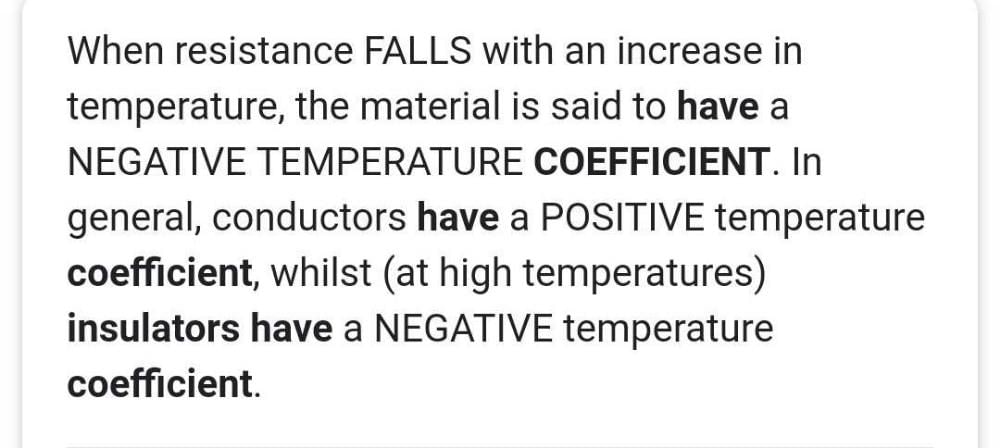Electrical Engineering (EE) Exam > Electrical Engineering (EE) Questions > Which of the following statements are true ab...
Start Learning for Free
Which of the following statements are true about insulators?
- a)Insulators have a positive temperature coefficient
- b)Insulators have a negative temperature coefficient
- c)Insulators have zero temperature coefficient
- d)Insulators have infinite temperature coefficient
Correct answer is option 'B'. Can you explain this answer?
Most Upvoted Answer
Which of the following statements are true about insulators?a)Insulato...
Insulators have a negative temperature coefficient because as temperature increases, the resistance of insulators decreases.
Free Test
FREE
| Start Free Test |
Community Answer
Which of the following statements are true about insulators?a)Insulato...


|
Explore Courses for Electrical Engineering (EE) exam
|

|
Question Description
Which of the following statements are true about insulators?a)Insulators have a positive temperature coefficientb)Insulators have a negative temperature coefficientc)Insulators have zero temperature coefficientd)Insulators have infinite temperature coefficientCorrect answer is option 'B'. Can you explain this answer? for Electrical Engineering (EE) 2025 is part of Electrical Engineering (EE) preparation. The Question and answers have been prepared according to the Electrical Engineering (EE) exam syllabus. Information about Which of the following statements are true about insulators?a)Insulators have a positive temperature coefficientb)Insulators have a negative temperature coefficientc)Insulators have zero temperature coefficientd)Insulators have infinite temperature coefficientCorrect answer is option 'B'. Can you explain this answer? covers all topics & solutions for Electrical Engineering (EE) 2025 Exam. Find important definitions, questions, meanings, examples, exercises and tests below for Which of the following statements are true about insulators?a)Insulators have a positive temperature coefficientb)Insulators have a negative temperature coefficientc)Insulators have zero temperature coefficientd)Insulators have infinite temperature coefficientCorrect answer is option 'B'. Can you explain this answer?.
Which of the following statements are true about insulators?a)Insulators have a positive temperature coefficientb)Insulators have a negative temperature coefficientc)Insulators have zero temperature coefficientd)Insulators have infinite temperature coefficientCorrect answer is option 'B'. Can you explain this answer? for Electrical Engineering (EE) 2025 is part of Electrical Engineering (EE) preparation. The Question and answers have been prepared according to the Electrical Engineering (EE) exam syllabus. Information about Which of the following statements are true about insulators?a)Insulators have a positive temperature coefficientb)Insulators have a negative temperature coefficientc)Insulators have zero temperature coefficientd)Insulators have infinite temperature coefficientCorrect answer is option 'B'. Can you explain this answer? covers all topics & solutions for Electrical Engineering (EE) 2025 Exam. Find important definitions, questions, meanings, examples, exercises and tests below for Which of the following statements are true about insulators?a)Insulators have a positive temperature coefficientb)Insulators have a negative temperature coefficientc)Insulators have zero temperature coefficientd)Insulators have infinite temperature coefficientCorrect answer is option 'B'. Can you explain this answer?.
Solutions for Which of the following statements are true about insulators?a)Insulators have a positive temperature coefficientb)Insulators have a negative temperature coefficientc)Insulators have zero temperature coefficientd)Insulators have infinite temperature coefficientCorrect answer is option 'B'. Can you explain this answer? in English & in Hindi are available as part of our courses for Electrical Engineering (EE).
Download more important topics, notes, lectures and mock test series for Electrical Engineering (EE) Exam by signing up for free.
Here you can find the meaning of Which of the following statements are true about insulators?a)Insulators have a positive temperature coefficientb)Insulators have a negative temperature coefficientc)Insulators have zero temperature coefficientd)Insulators have infinite temperature coefficientCorrect answer is option 'B'. Can you explain this answer? defined & explained in the simplest way possible. Besides giving the explanation of
Which of the following statements are true about insulators?a)Insulators have a positive temperature coefficientb)Insulators have a negative temperature coefficientc)Insulators have zero temperature coefficientd)Insulators have infinite temperature coefficientCorrect answer is option 'B'. Can you explain this answer?, a detailed solution for Which of the following statements are true about insulators?a)Insulators have a positive temperature coefficientb)Insulators have a negative temperature coefficientc)Insulators have zero temperature coefficientd)Insulators have infinite temperature coefficientCorrect answer is option 'B'. Can you explain this answer? has been provided alongside types of Which of the following statements are true about insulators?a)Insulators have a positive temperature coefficientb)Insulators have a negative temperature coefficientc)Insulators have zero temperature coefficientd)Insulators have infinite temperature coefficientCorrect answer is option 'B'. Can you explain this answer? theory, EduRev gives you an
ample number of questions to practice Which of the following statements are true about insulators?a)Insulators have a positive temperature coefficientb)Insulators have a negative temperature coefficientc)Insulators have zero temperature coefficientd)Insulators have infinite temperature coefficientCorrect answer is option 'B'. Can you explain this answer? tests, examples and also practice Electrical Engineering (EE) tests.

|
Explore Courses for Electrical Engineering (EE) exam
|

|
Signup for Free!
Signup to see your scores go up within 7 days! Learn & Practice with 1000+ FREE Notes, Videos & Tests.


















